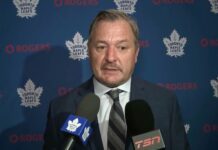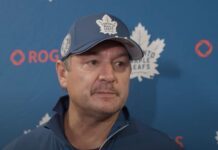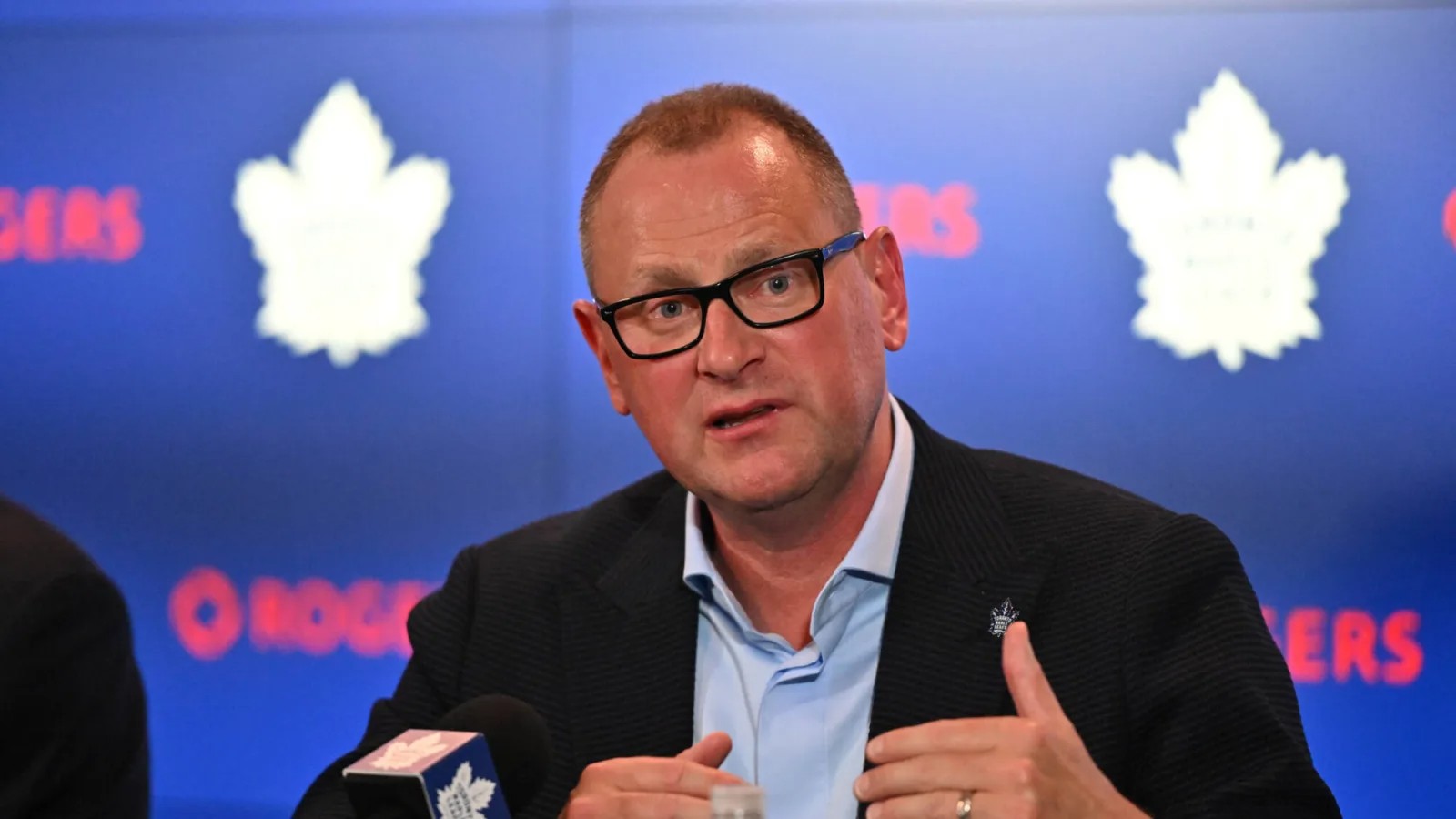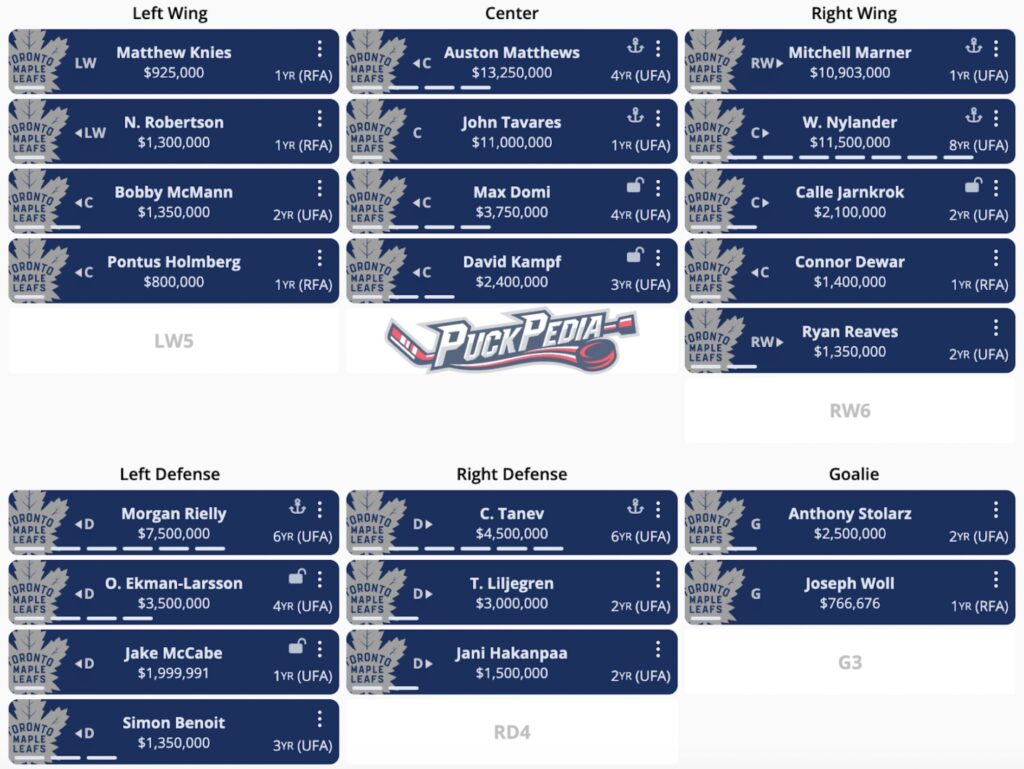Just over a week into free agency, the Maple Leafs have filled some holes, but there is still plenty of work to do.
Heading into the offseason, we identified the team’s four primary needs (in no particular order):
- Two real top-four defensemen
- A legitimate top-nine center
- A quality left winger (this does not need to be a top-line player by any means)
- A good goalie option in net to tandem with Joseph Woll and likely a (veteran) third stringer behind those two as injury insurance
The Leafs have clearly focused on improving their defense and goaltending first, which is understandable. They have signed Oliver Ekman-Larsson and Chris Tanev on defense, while adding Anthony Stolarz and retaining Matt Murray in net. Their forward group, which was second in the league in goals last season, is essentially the exact same, except for Tyler Bertuzzi’s departure.
However, as things stand today, they can’t afford to round out their forward group with their two remaining RFAs, Connor Dewar and Nick Robertson. With 11 forwards, seven defensemen, and two goalies under contract, the Leafs have roughly $2.055 million in cap space while still needing to sign the pair.
They might seem like minor signings, but the Leafs likely can’t afford to sign both and call it a day. Dewar just filed for salary arbitration and has a better case than many likely anticipate. He scored 11 goals this season, averaged 11:39 per night, and was a solid penalty killer on two separate teams while playing center and wing. AFP Analytics projects his salary at $1.43 million. Because Dewar filed for arbitration, the Leafs can only walk away if the award is $4.74 million or more, which it obviously won’t be. Even if the Leafs won the arbitration hearing and his salary fell in the $1.15 million range – more than reasonable for a potential double-digit goal-scoring checking winger with some ability to play center, penalty kill, and push play up the ice well – they still wouldn’t have enough to keep Robertson.
Robertson’s qualifying offer is $813,750, but he is in line for a raise following a 14-goal, 27-point season in just 56 games. AFP Analytics projects Robertson’s salary at $1.38 million. Even if we round down both projected numbers to $1.4 million and $1.3 million deals (giving the Leafs 14 forwards, seven defensemen, and two goalies), they would be roughly $645K over the salary cap with this roster:
Even if you wanted to argue that Dewar and Robertson are overpaid by hundreds of thousands above, they will still – rightfully – combine to make over $2 million without blinking. The Leafs can’t fit this roster under the cap ceiling.
The only waiver-eligible player listed above is Matthew Knies, and sending him down to be cap-compliant is (or should be) a non-starter, as he’s arguably the team’s best left winger. Technically, they can simply waive someone, still carry an extra body, and become cap-compliant, but the question of who to waive becomes tricky unless they are willing to waive Ryan Reaves at forward.
On defense, it would be hard to imagine them waiving any of those players listed, as all of them are solid NHL defensemen and would be claimed. But there is the question surrounding Jani Hakanpaa in general.
Hakanpaa is not listed on the Leafs’ roster on their official website, and the Leafs have not formally announced the signing. Although Brad Treliving did acknowledge the acquisition in his July 1 press conference, they have yet to confirm his contract, which leads one to believe that there is some validity to the reported knee issue. At the very least, it might be fair to suggest that the contract isn’t officially done.
That said, if we swapped Hakanpaa out for Conor Timmins, the Leafs still couldn’t fit the roster under the cap unless they could whittle down Dewar and Robertson’s salaries by at least a combined $250K (which is certainly possible). Or Dakota Mermis could be their seventh defenseman, which could work cap-wise.
However, it leads to different questions if they go the route without Hakanpaa. While the Leafs have added Chris Tanev and Oliver Ekman-Larsson and retained Timothy Liljegren, the absence of Hakanpaa notably impacts the defense’s outlook.
With a healthy Hakanpaa, I’d argue the Leafs found a really nice balance amongst their top seven defensemen in terms of handedness, skill, physicality, and defensive prowess. A healthy Hakanpaa would instantly become their second or third-best penalty killer behind Chris Tanev and maybe Jake McCabe, either playing on the top unit or driving the second unit. For a Leafs penalty kill that finished 23rd last season, it’s a very important addition. They can’t ask Chris Tanev to do it all, and frankly, at Tanev’s age, an option like Hakanpaa to spell Tanev throughout an 82-game season would be a valuable resource.
Hakanpaa is a defensive specialist, largely used in difficult minutes with tons of defensive zone faceoffs and penalty killing. He isn’t going to offer much offensively, and he generally hasn’t moved the puck well enough to be a full-fledged top-four. But he plays his role well. He’s essentially a bigger, more mature, and right-handed version of what Simon Benoit ideally becomes.
That meshes well with the OEL acquisition as, ideally, OEL is deployed in the exact opposite manner. In Florida, OEL started in the offensive zone 57.65 percent of the time, the highest mark of his career. In his first season in Vancouver, he recorded the lowest offensive zone start percentage of his career and – not coincidentally – the lowest points per game output of his career. He is an offense-first player – which is fine; it’s a huge need for the Leafs – but it’s fair to question if he’s a well-rounded, full-on, top-four defenseman at this point. He’s coming off his lowest time on ice per game season since his rookie year 13 seasons ago, and he played under 16 minutes per game in the playoffs. This all means the Leafs need enough quality elsewhere to best optimize OEL.
Perhaps they still can, as Benoit and McCabe capably filled that type of role last season as a pairing, but it forced McCabe to play on the right, and Benoit hasn’t established himself on the penalty kill. But the general idea of a Rielly – Tanev top pairing, an offensive OEL – Liljegren pairing, and a defensive McCabe – Hakanpaa/Benoit pairing is a good mix. It has real potential to fit together well and form a strong unit overall.
The defense has improved with or without Hakanpaa, in part because the bar was so low. However, without him, it still feels like they would need to acquire another defenseman by the time the trade deadline rolls around unless a few players really step up this season. That’s relevant to the cap situation; we don’t have a resolution yet with Hakanpaa, and even if he is ultimately signed, it’s tough to fully trust his ability to stay healthy.
At forward, there is much to be determined. The Leafs need to move cap dollars to fit in player(s), and several young players could receive early looks. Max Domi should fill one of the top nine spots, be it center or on the wing, but they don’t have the cap space to keep both Robertson and Dewar (unless the Hakanpaa contract completely fell through). Even if they did squeeze both in, they would likely need to buy at the deadline anyway unless all of Knies and McMann and Domi (at center or wing) perform well in the top nine and one of Robertson, Holmberg, or a rookie (Easton Cowan, Fraser Minten, etc.) grabs a spot and runs with it.
It’s certainly possible – and maybe (arguably) it’s worth trying for the first half of the season to see which young players can stick – but part of the equation is that the Leafs aren’t primed with the assets to buy big at the deadline. They have a second-round pick in 2025 to dangle, their first in 2026, or prospects they may or may not be willing to move (Minten, Cowan, Danford, etc.). That’s it.
I’m also mindful of Brad Treliving’s approach to the trade deadline last season:
“I also think you have to be careful on the trade deadline. We will continue to watch our team, but I am not a big believer that you make your team (at the deadline). You have to be careful with that.
Are there tweaks that you’d like to do? Sure.”
One way or another, a shoe has to drop.
Last offseason, Treliving waited until the end of the preseason to trade Sam Lafferty and become cap compliant. But this shouldn’t be about just becoming cap complaint. Arguing over a few hundred thousand dollars either way to squeeze in Dewar and Robertson to return the same forward group minus a 21-goal-scoring veteran while banking on youth (Cowan, Minten, Grebyonkin) and second-year players (Knies, McMann, Holmberg, Robertson) to produce amounts to a whole lot of hope, which is not a plan. It would make a ton of sense for a team that is still developing. It doesn’t add up for a team that paid big bucks to hire a Cup-winning coach, is slated to run back their core for a seventh year, and just paid multiple veteran defensemen long-term.
The Leafs made some sensible additions on defense and took steps to solidify their goaltending by locking in Woll for the next four seasons, adding a tandem partner, and signing a veteran third goalie. The forward group is both incomplete and unaffordable, though.
The two most logical options at this point are to add either a two-way center for the third line – allowing Max Domi to move up the lineup as a winger and focus on what he does best with his playmaking – or a solid left winger to play up the lineup. The LW could play alongside Matthews and Marner, although lining up with Nylander on the second line would also work so that the Leafs aren’t relying on both Knies and McMann to be full-time top-six wingers.
The only way either of the options above could transpire at this point is via trade. Can the Leafs package some salary (David Kampf or Calle Jarnkrok) along with a young player to upgrade one of those two spots?
We’ll wait to see how Treliving addresses the remaining need up front before we take full stock of his 2024 offseason.

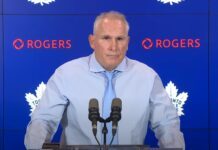


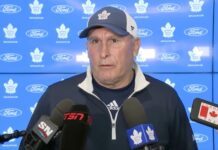
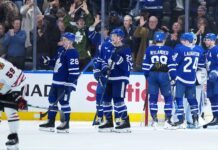
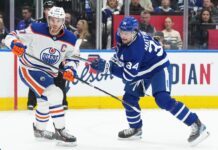


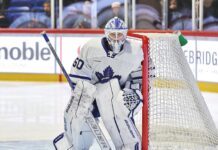


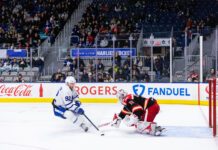
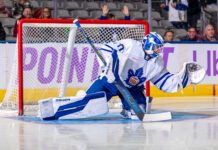
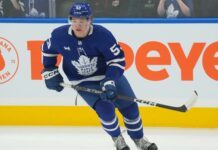
![John Gruden after the Leafs prospects’ 4-1 win over Montreal: “[Vyacheslav Peksa] looked really comfortable in the net… We wouldn’t have won without him” John Gruden, head coach of the Toronto Marlies](https://mapleleafshotstove.com/wp-content/uploads/2025/09/gruden-post-game-sep-14-218x150.jpg)
